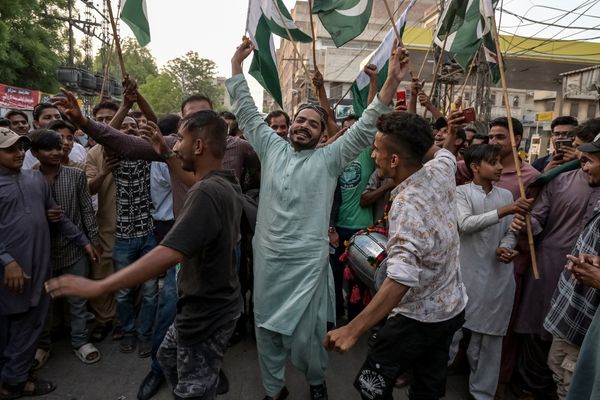
At the linguistic centre of Saturday’s coronation of King Charles III was, unsurprisingly, the “coronation oath.” Its first and most important line required the King to intone, before God and the world, that he did
solemnly promise and swear to govern the Peoples of the United Kingdom of Great Britain and Northern Ireland, [my] other Realms and the Territories to any of them belonging or pertaining, according to their respective laws and customs.
Having inherited the throne the instant his mother died eight months ago, Charles is not a new king. Decoded, the oath involved him pledging to abide by the most fundamental principle of the rule of law under a constitutional monarchy like Australia’s or Britain’s. It was a “crucial” moment of “commitment.”
If anyone paused during the elaborate forty-page liturgy they may have thought: “Hang on, we’ve had a king for eight months and he’s only now agreed to the rule of law?” Did it matter that Charles waited that long to solemnly pledge not to reassert the Crown’s once limitless powers? The answer is no, and yes. Unpacking this ritual and performance is a lesson itself.
As millions saw at the weekend, a crown (which must sometimes have felt Damoclean to the man formerly known as Charles Philip Arthur George) finally came to rest on a fresh, if greying, head. That lowering of what the Historic Royal Palaces trust calls the “most important and sacred of all the [British] crowns” was the ultimate visual symbol of the ceremony.
Amid all the pomp and pomposity, there was plenty of legal magic and palaver too. In its current meaning, the oath dates back to 1688 — a momentous year in a momentous century, not just for Britain but also for the system of government that Empire brought to this continent.
The Coronation Oath Act of 1688 was passed in the wake of a civil war that had culminated in the first King Charles losing not just his crown but also his head. The act reinforced a Protestant ascendancy whose sectarian ripples irk Charles III and are felt in Northern Ireland to this day.
For the secular world, the Oath Act reinforced the claim of parliament to be not just the ultimate lawmaker but also sovereign over the Sovereign. Charles gets to be King because parliament allows it, not because God ordained his bloodline.
As the monarch, Charles is not subject to legal proceedings. Like his mum, he has deigned to pay taxes on the income from his vast wealth; unlike his local subjects, he has inherited yet more wealth free of estate duties. But his bejewelled crown is a titular symbol: “the Crown” is a virtual space in which the law of the three branches of government reign.
The long delay in holding the coronation seems partly due to Charles’s desire to settle in: to be seen out and about in a job held by his mother since 1953. Partly, also, he wanted to rejig the ceremony and oil the rusty cogs of a logistically complex show not performed for seventy years.
Besides shaking hands and opening fetes, what had Charles done formally to signify and “accede” to his kingship since the Queen’s death on 8 September last? The Westminster parliament happened to be sitting that week, so when it met the next day a kind of mutual obeisance took place. MPs all swore allegiance to Charles and, for his part, he gave his first, brief, King’s Address. In it, he paid tribute to “darling Mama” and said he would “uphold the constitutional principles at the heart of our nation.”
Although parliament must, by law, keep sitting on the “demise” of a monarch, it filled eleven hours’ worth of Hansard with further tributes before adjourning for an extended mourning period. A day later, Charles appeared with “his” Privy Council, whose members publicly proclaimed him King. Before them, he repeated the sentiment that he’d “strive to follow” his mother’s example “in upholding constitutional government” across his realms.
None of those words were a binding oath. An oath is a kind of visible, audible and public contracting. As a University College London report puts it, the coronation oath
requires the sovereign to declare and identify with the effect of the law at a public moment of great solemnity… [It is] performative and affirmative rather than legislative… The weight of the oaths lies overwhelmingly in their symbolic significance and, moreover, in making that symbolism intelligible, acceptable and inspiring to a modern population.
As Prince of Wales, Charles became well known for his public pronouncements on everything from the built environment to the natural environment. He couldn’t help sharing his opinions with the British government as well, via letters he handwrote to ministers in spidery black ink. As a friend, a retired miner, quipped, “Let’s hope he keeps his oath better than his wedding vows.” To be fair, he has been more circumspect as King: a folksier but no less bland version of his mother.
The coronation oath is hardly the only source of the principle of sovereignty under the law. The highest courts in the United Kingdom and Australia have reiterated and applied the idea in various cases. Despite the possibility being imagined in an award-winning 2014 play, if Charles did ever lose his (mental) head and begin directing affairs, governments would pay as much heed to him as plants do when he talks to them.
For Australia’s part, the King’s men in Canberra — the governor-general, flanked by our prime minister — proclaimed him King of Australia on 12 September. Similarly circular instances of viceroys proclaiming the “Roy” occurred at state level too. The “King of Australia” title dates to Whitlam-era legislation, and he is concreted into our 1901 Constitution as our head of state.
Nowhere does Australia’s Constitution explicitly recognise that our sovereign is not our dictator, except in occasional cryptic references to his agent, the governor-general, “acting in Council.” In other words, acting after formally receiving advice from the ministers he appoints. Given that the Constitution doesn’t even mention the office of the prime minister, those appointments are seemingly at his discretion.
We are neither a dictatorship nor a republic, of course, but a constitutional monarchy. The Constitution makes little sense without a brace of unwritten but deeply held conventions. Australians usually feel we are not just less class-bound than Britain but also more modern. At least our governor-general can be of any or no religion. But when it comes to issues of sovereignty we are not always ahead of the Brits.
They may still have a Coronation Oath Act of 1688 that spells its legislature “Parlyament,” but they have several times modernised the words of the ceremony. Flexible convention can even nuance legislation.
In 1688 the United Kingdom was a unitary state, ruled solely from London. Now it has three sub-national assemblies with significant power over the more Celtic countries of Wales, Scotland and Northern Ireland. Indigenous Australia may only later this year gain a merely advisory Voice to Parliament if we embrace the idea by referendum. In 2016 Britain elected to leave Europe; in 1999 we voted to stay in the arms of a distant Crown.
What then is the point of an event like the weekend’s crowning? For many Brits it was an excuse for cheers — for others, boos and jeers — at a fraught time politically and economically. For most Australians it was a sideshow, even a yawn. Yet even a few republicans responded less with curmudgeon than curiosity. Rituals catch something in the spirit. They punctuate and help us measure and remember the passing years.
So, too, do assassinations and wars. This means that rituals have to be more than events, and must embody positive meaning. Simon Schama in the Financial Times mused on whether the coronation spoke to modern Britain. He assayed the colourful (literally and euphemistically), millennium-old traditions surrounding the comings-and-goings of kings and queens. When most surviving monarchies have trimmed down to be more “of” the democratic state than above or apart from it, “our” monarchy looks distinctly odd.
During seventy coronationless years, Queen Elizabeth watched her “family firm” straddle dysfunctional celebrity status and gilded, performative rituals whose traditions are meant to bind. It would have been a wee bit more coherent had Charles not waited so long to bind himself to the democratic principle embodied in his oath.
Yet the demos wants more than promises or traditions, it wants clickbait. Hello! magazine recently featured Charles’s daughter-in-law Kate on twenty-one consecutive covers, all in flattering poses. Its rivals in the media chase his other daughter-in-law, Meghan, like bloodhounds. As the King returns to more mundane duties in the shadow of the rising brood of royals he begat, he might reflect on traditions old and new. •
The post ’King oath appeared first on Inside Story.






